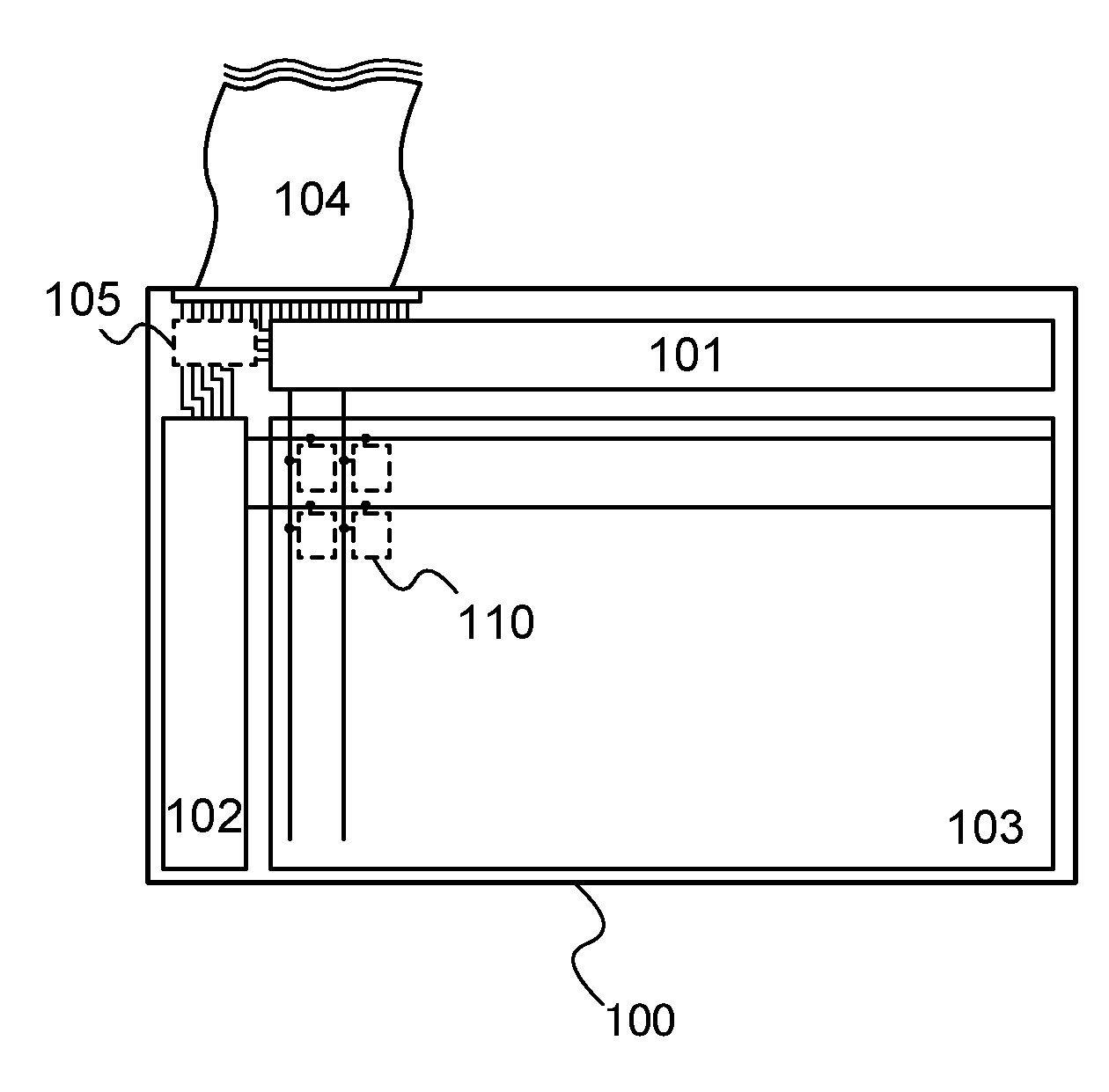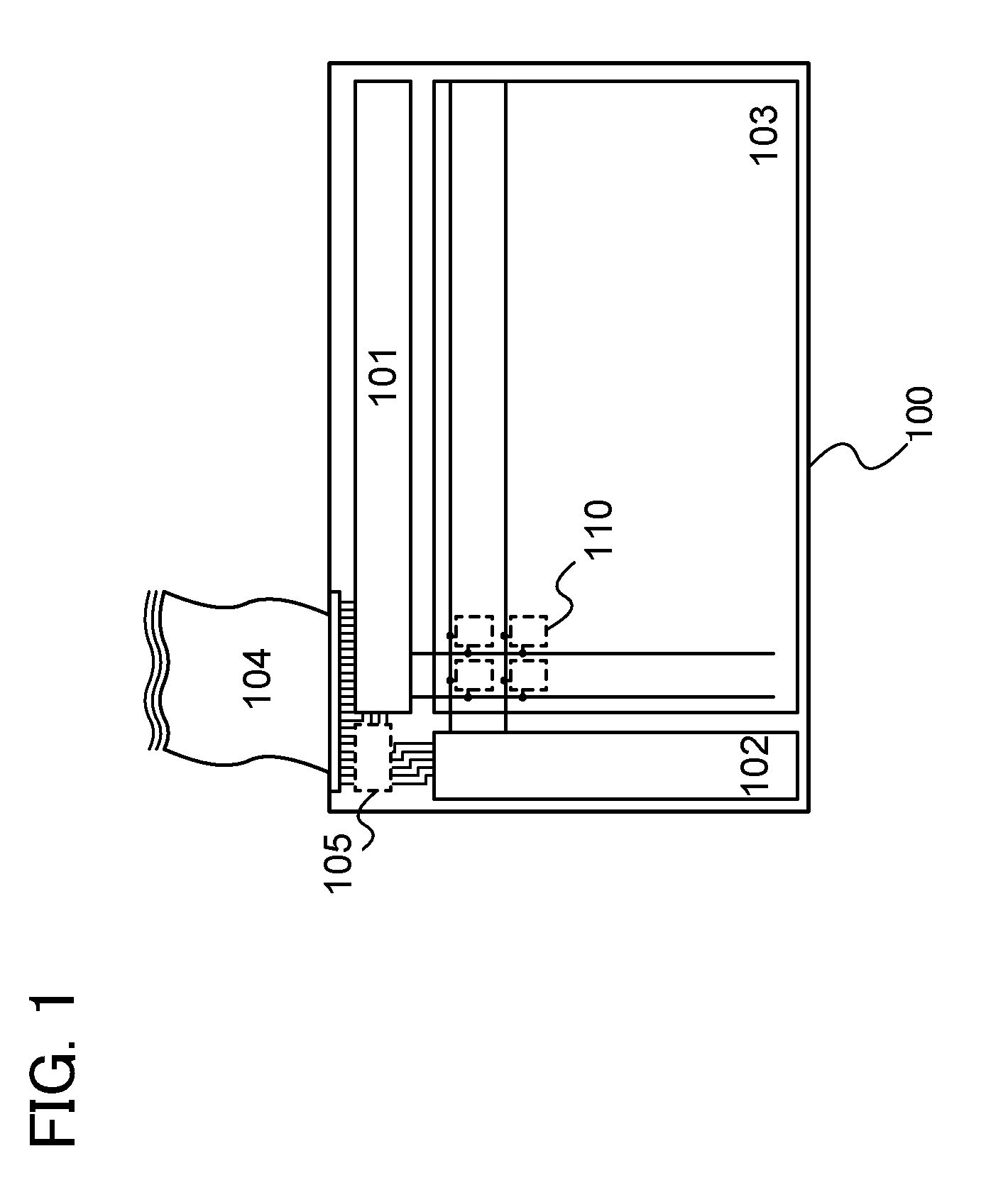Driver circuit and display device
a technology of drive circuit and display device, which is applied in the direction of electrical apparatus casing/cabinet/drawer, pulse technique, instruments, etc., can solve the problems of deterioration of oxide semiconductor over time, increase of manufacturing cost, and remained variation of threshold voltage due to oxide semiconductor deterioration
- Summary
- Abstract
- Description
- Claims
- Application Information
AI Technical Summary
Benefits of technology
Problems solved by technology
Method used
Image
Examples
embodiment 1
[0042]In this embodiment, an n-channel thin film transistor is used as a thin film transistor including an oxide semiconductor which forms a unipolar driver circuit. An advantage of one mode of the present invention is to be described by giving an example of a source line driver circuit and / or a gate line driver circuit as a driver circuit for driving a pixel portion.
[0043]First, FIG. 1 shows an overall schematic view of a display device. A source line driver circuit 101, a gate line driver circuit 102, and a pixel portion 103 are integrally formed over a substrate 100. In the pixel portion 103, a portion surrounded by a dotted flame 110 is one pixel. Although an example in FIG. 1 shows a structure in which the gate line driver circuit 102 is provided for one end portion, a structure including a plurality of gate driver circuits 102 may be applied. Further, in a pixel of a display device, a thin film transistor (hereinafter referred to as a TFT) controls a display element. A signal ...
embodiment 2
[0146]The above embodiment shows an example of a shift register of a static circuit as a shift register in a driver circuit of a display device. In this embodiment, an example of a driver circuit including a shift register of a dynamic circuit is described.
[0147]A structure of a pulse output circuit included in a shift register of a dynamic circuit is described with reference to FIGS. 14A to 14D. A pulse output circuit 1400 shown in FIG. 14A, as an example, includes an inverter circuit 1401 in which a start pulse SP is input from an input terminal, a switch 1402 of which one of terminals is connected to an output terminal of the inverter circuit 1401, and a capacitor 1403 connected to the other terminal of the switch 1402. Note that on / off of the switch 1402 in a pulse output circuit in an odd-numbered stage is controlled by the first clock signal (CLK1). On / off of the switch 1402 in a pulse output circuit in an even-numbered stage is controlled by the second clock signal (CLK2).
[01...
embodiment 3
[0157]In this embodiment, a manufacturing process of a display device including a driver circuit is described with reference to FIGS. 16A to 16C, FIGS. 17A to 17C, FIG. 18, FIG. 19, FIG. 20, FIG. 21, FIGS. 22A to 22D, and FIG. 23.
[0158]In FIG. 16A, for a light-transmitting substrate 1600, a glass substrate of barium borosilicate glass, aluminoborosilicate glass, or the like can be used.
[0159]Next, after a conductive layer is formed over the entire surface of the substrate 1600, a first photolithography step is performed to form a resist mask, and an unnecessary portion is removed by etching, whereby wirings and an electrode (a gate wiring including a gate electrode layer 1601 of a pixel TFT portion, a capacitor wiring 1608 of a capacitor portion, and a first terminal 1621 of a terminal portion) are formed. At this time, the etching is performed so that at least an end portion of the gate electrode layer 1601 is tapered. A cross-sectional view of this step is shown in FIG. 16A. Note ...
PUM
 Login to View More
Login to View More Abstract
Description
Claims
Application Information
 Login to View More
Login to View More - R&D
- Intellectual Property
- Life Sciences
- Materials
- Tech Scout
- Unparalleled Data Quality
- Higher Quality Content
- 60% Fewer Hallucinations
Browse by: Latest US Patents, China's latest patents, Technical Efficacy Thesaurus, Application Domain, Technology Topic, Popular Technical Reports.
© 2025 PatSnap. All rights reserved.Legal|Privacy policy|Modern Slavery Act Transparency Statement|Sitemap|About US| Contact US: help@patsnap.com



